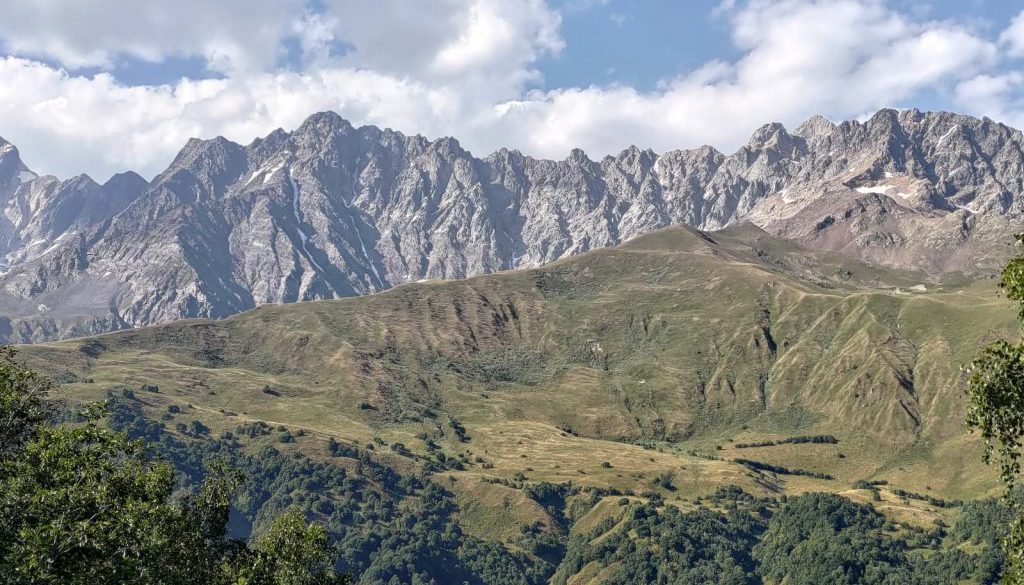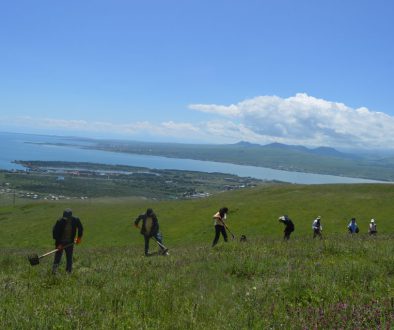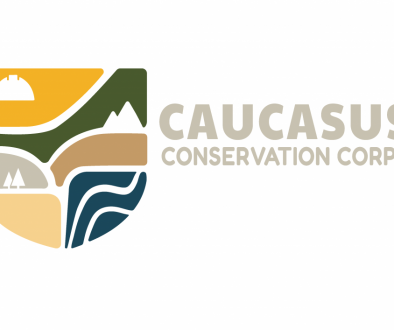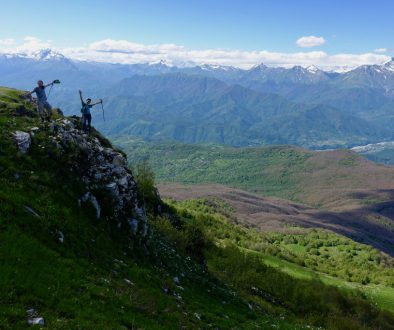Building the Transcaucasian Trail: A volunteer’s week on the TCT
This post was written by 2022 volunteer Elizabeth Yancey, and originally published on ArcGIS StoryMaps. You can view the original here.
Thanks for sharing your experience, Elizabeth– we can’t wait to welcome more volunteers next year! Stay tuned for 2023 volunteer dates and information, coming soon.
What is the TCT?
I learned of Transcaucasian Trail (TCT) as I was coming off the high of completing my first multiday hike, and having lived in Georgia from 2011-2013, I was fascinated by this 1500km trail spanning the Caucasus countries of Georgia, Armenia, and Azerbaijan. The TCT crosses several of the region’s national parks, showcasing the Caucasus’ natural beauty, and it incorporates numerous local trails that were traditionally used to connect one village with another. Many of these villages still exist, and the trail is designed in part with the goal of bolstering the local economy while providing hikers with the opportunity to experience Georgian culture and cuisine at the many guesthouses along the route.
Although much of the trail is still under development, many individual sections have been welcoming hikers for the past several years. The TCT Association (TCTA) officially launched the first national section of the TCT in Armenia in 2021, and although the Georgian section in Upper Svaneti is mostly complete, hikers are still required to bushwhack through several mountainous kilometers.

Volunteer Application & Arrival
A call for volunteers to build this section of the TCT was prominently displayed on the TCT website, and I immediately applied, eager to return to one of the most beautiful, hospitable countries I had ever visited. I soon received an acceptance email that confirmed I would be joining Group 10, the season’s last international volunteer group. The volunteer guide and packing list attached to the email were quite thorough and helpful as I prepared for the journey back to Georgia.
I arrived at the TCT volunteer house in Kutaisi, Georgia’s second largest city, on August 19 and met the other members of my group, a young German man and two returning Georgian volunteers. Because the international and Georgian volunteer groups overlapped, we would be working on the trail with a total of 14-16 people, including our group leaders and site coordinator.
The next morning, we embarked on the 5-hour drive to the volunteer camp, located at an elevation of 1900m in a remote clearing where we would be living for the next week. We slept in tents, drank filtered water from the river, cooked food on camp stoves, and forwent cell service, all of which enabled us to bask in the beauty of our surroundings, focus on our trailwork, and build connections with each other.

When we arrived at the camp, we were greeted by members of the international volunteers of Group 9, who would be departing the following day, and the current Georgian volunteer group, who would be leaving the following week. Another group of Georgian volunteers would arrive on the day of their departure, so the number of total people in camp would remain steady throughout the week. Most of the Georgians knew English quite well, so we could communicate with each other easily.
Our only tasks that first day involved setting up our tents and settling in. We would be added to the rotation of camp chores (wake-up, collect and filter water, cook dinner, and wash dishes) the following day.
Daily Schedule
6:10 Wake Up
The wake-up crew’s calls of “Gaighvidzet!” and “Time to wake up!” ensured everyone was awake and ready for the day.
6:30 Breakfast
Breakfast for the week consisted of oatmeal augmented with cookies, peanut butter, or whatever else people chose to add to their bowl and tea, coffee, or hot chocolate. I held my mug tightly as I huddled by the morning fire, envying the other volunteers who were not nearly as bundled up as I was and yet seemed perfectly content in the morning mountain air. Although it was August, I found mornings, evenings, and nights to be quite cold.
7:00 Safety Circle
At the call of “Safety circle!” everybody formed a large circle, and someone broached the Question of the Day, such as “What superpower would you have?” Each person answered the question, led the group in a lunge, shoulder rotation, or other stretch, and offered a safety reminder for the day, like “Drink enough water” or “Don’t forget to bring your rain gear.” Trailwork was weather-dependent, and if it rained heavily, we would stop work and return to camp. I was fortunate to see nothing but sunshine during my time on the mountain, but former volunteer crews hadn’t been so lucky.
8:00 Depart for Work Site
We carried our daypacks filled with water, trail mix, rain gear, and sunscreen the 2 km separating our camp from the work site.

Upon arrival, we donned gloves, hardhats, and protective glasses (safety was paramount) before breaking into mixed groups of Georgian and international volunteers to brush or bench a section of the trail. Brushing involved clearing the vegetation in preparation for a new segment of trail, and benching consisted of leveling the trail and creating a backslope and downslope to prevent water buildup and subsequent erosion.
Although I had hiked numerous trails, I had never been involved in the construction of one, and the specific skills and terminology involved were foreign to me. The group leaders thoroughly explained and demonstrated how to conduct each step of the trailwork, however, and monitored our progress. Over the course of the week, I became intimately familiar with McLeods, shovels, pruners, and clippers, and developed an eye for determining what the word flat and a 45° backslope should each look like.



10:00 10-minute Break
The morning water and trail mix break was always welcome after a couple hours of physically demanding work. If we needed a break at any other time of day to rest or hydrate, we were encouraged to take one.
12:00 Lunch
We gathered together as a group to make our own sandwiches, stuffing them with a smorgasbord of cheese, sausage, tomatoes, cucumbers, and hummus, accompanied by peanut butter, cookies, and sour candy.
14:00 10-minute Break
Trail mix time! Afternoons were often sweltering, so we enjoyed our break in the comfort of the shade.
16:00 Depart for Camp and Free Time
At the end of the work day, we cleaned up our work site and trekked down the mountain to enjoy free time until dinner. Some bathed or relaxed in the river, others napped, and I typically read in the sunshine next to my tent.
19:00 Dinner
We took turns making dinner, which were simple affairs consisting of pasta, soup, rice, or beans. After a hard day’s work, many took advantage of the copious amounts of food and helped themselves to seconds and thirds.
Free Time
After dinner (or washing dishes for those on dish duty that day), we were free to spend the rest of the night as we pleased. Many people relaxed around the fire, chatting or making music with the guitar one of the volunteers brought. I usually retired to my tent early, tired from the long day, but not before taking time to gaze at the brilliant display of stars overhead.
Day Hike
Towards the end of the week, everyone went on a day hike in lieu of working on the trail. We trekked up a different mountain than the one the TCT followed, and the wild blueberries and stunning views of the nearby mountains and valleys were well worth the steep climb to the top.

Departure
At the end of the week, I reluctantly packed up my tent, said goodbye to the Georgian volunteer group who was staying a few more days, and climbed into the van with the rest of my group for the ride back to Kutaisi, civilization, and the oppressive summer heat. We ate lunch at the volunteer house, and when some volunteers departed back to Tbilisi or continued on their journeys elsewhere, I washed my laundry and aired out my sleeping bag, planning on staying one more night at the house to relax and reflect on the week working and living in the mountains.
Reflection
My week volunteering on the TCT was incredible, to say the least, and I came away with new skills, new friends, and a deep appreciation for everyone who has built a trail along the side of a mountain. I consider myself fortunate to have stumbled upon this opportunity, and afterwards, I hiked the finished section of the TCT in Svaneti from Nakra to Ushguli, which will eventually connect with the trail section I worked on as a volunteer.
I was proud to have contributed to this trail, knowing that others will one day walk along the path I helped create, and I was extremely humbled, understanding my work was only a small part of the TCTA’s overall vision. I am eager to return to the Caucusus and discover the other sections of the TCT, learn more about the communities along the trail, and encourage others to discover the trail for themselves, especially as a volunteer.

Post written by summer 2022 volunteer Elizabeth Yancey.
Stay tuned for future volunteer opportunities in 2023!






